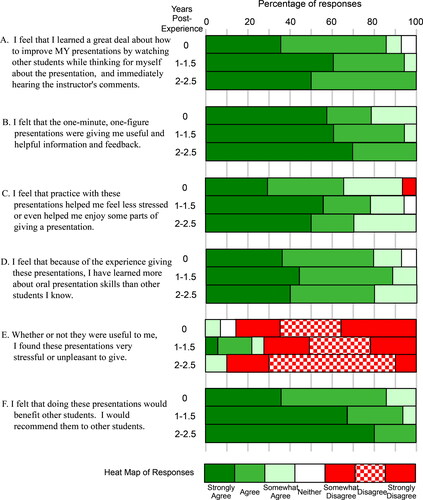Figures & data
Figure 1. Responses to six questions from surveys administered after student experiences with one-minute presentations at intervals of 0, 1-1.5, and 2-2.5 years (N = 14, 18, and 10 respondents, respectively). Questions A – F are listed in the left-most column. For each question, the horizontal bars show the percentage of students choosing strongly agree, agree, somewhat agree, neither agree nor disagree, somewhat disagree, disagree or strongly disagree, showing cumulative percentages in order from left (strongly agree) to right (strongly disagree). The heat map indicates color and pattern coding for the responses.

Figure 2. Survey responses from two text-response questions asking respondents to: (1) “List up to three things about what you gained, or what you liked, from doing the one-minute, one-figure presentations. If there are none, please write none."; and (2) “Can you reflect on the impact of these presentations on your oral presentation skills? Is there any additional information or feedback you would like to offer?” The columns show the percentage of respondents that included references interpreted as being in the nine categories shown.
(Key words/phrases used to help define each category were as follows:
Confidence – confidence, comfort, less fear, less anxiety; Skill Development – skill, ability, eye contact, audience skills, um, ah, like, uptalk, intonation, voice, movement, using notes, and stutter; Feedback & Focus – feedback, focus, critique, simplicity, awareness, bad habits, progression, improve; Fast & Efficient – short, brevity, not longer, small time frame, not a large amount of time, prepared in class, increased ability to prepare on the fly, efficient, concise [with connotation of presentation time]; Practice Frequently – practice, experiment, play around with different things, doing it a lot, in front of peers constantly; Low Pressure – play, camaraderie, low stress, comfortable environment, casual environment, not as daunting, not judged; Using Time & Timing – time, timing, pacing, slow enough speech, concise [with connotation of the structure of a presentation], time management; Audience Interaction – audience, providing feedback to other presenters, actively nodding, show attention, watching others; Selecting Material – choose important information, gather my thoughts, leave out information, good introduction, figures that aid my presentation, think about the main point.)
![Figure 2. Survey responses from two text-response questions asking respondents to: (1) “List up to three things about what you gained, or what you liked, from doing the one-minute, one-figure presentations. If there are none, please write none."; and (2) “Can you reflect on the impact of these presentations on your oral presentation skills? Is there any additional information or feedback you would like to offer?” The columns show the percentage of respondents that included references interpreted as being in the nine categories shown.(Key words/phrases used to help define each category were as follows:Confidence – confidence, comfort, less fear, less anxiety; Skill Development – skill, ability, eye contact, audience skills, um, ah, like, uptalk, intonation, voice, movement, using notes, and stutter; Feedback & Focus – feedback, focus, critique, simplicity, awareness, bad habits, progression, improve; Fast & Efficient – short, brevity, not longer, small time frame, not a large amount of time, prepared in class, increased ability to prepare on the fly, efficient, concise [with connotation of presentation time]; Practice Frequently – practice, experiment, play around with different things, doing it a lot, in front of peers constantly; Low Pressure – play, camaraderie, low stress, comfortable environment, casual environment, not as daunting, not judged; Using Time & Timing – time, timing, pacing, slow enough speech, concise [with connotation of the structure of a presentation], time management; Audience Interaction – audience, providing feedback to other presenters, actively nodding, show attention, watching others; Selecting Material – choose important information, gather my thoughts, leave out information, good introduction, figures that aid my presentation, think about the main point.)](/cms/asset/1d928600-984b-4361-aa97-05f5b8c466be/vcol_a_1913395_f0002_b.jpg)
